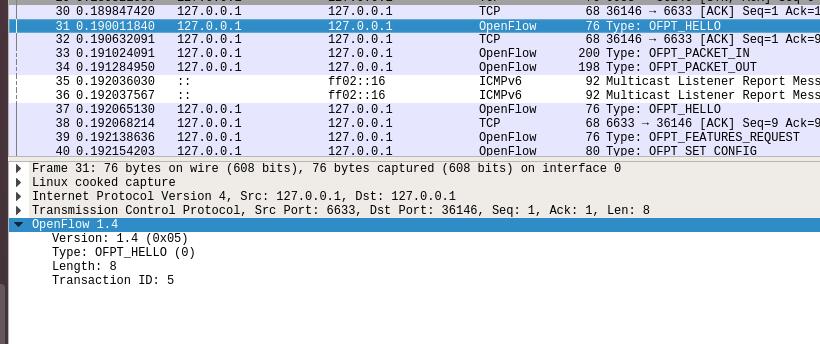1. 利用Mininet仿真平台构建如下图所示的网络拓扑,配置主机h1和h2的IP地址(h1:10.0.0.1,h2:10.0.0.2),测试两台主机之间的网络连通性
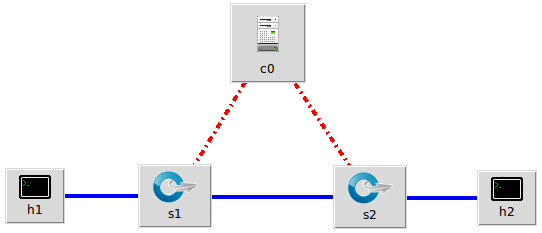
2. 利用Wireshark工具,捕获拓扑中交换机与控制器之间的通信数据,对OpenFlow协议类型的各类报文进行分析,对照wireshark截图写出你的分析内容。
.
.
.
hello消息
控制器与交换机建立连接时由其中某一方发起Hello消息,双方协调协议版本号。Hello消息只有openflow包头,没有主体部分。头部结构如下:
/* Header on all OpenFlow packets. */
struct ofp_header {
uint8_t version; /*版本*/
uint8_t type; /*消息类型*/
uint16_t length; /*消息总长度,包含头部*/
uint32_t xid; /*事件ID,同一件事件的ID号一致如feature_request和对应的feature_reply就使用同一个Transaction id,但是两个hello消息的Transaction id并不相同,不过据实验结果看两个id一般是两个相邻的数字。*/
};
OFP_ASSERT(sizeof(struct ofp_header) == 8);
抓包结果如下:
控制器6633端口最高支持1.0版本,交换机35968端口
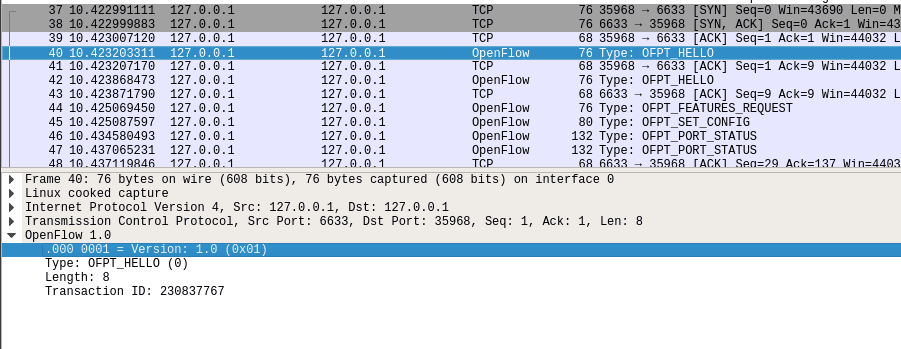
交换机35968端口最高支持1.3版本,控制器6633端口
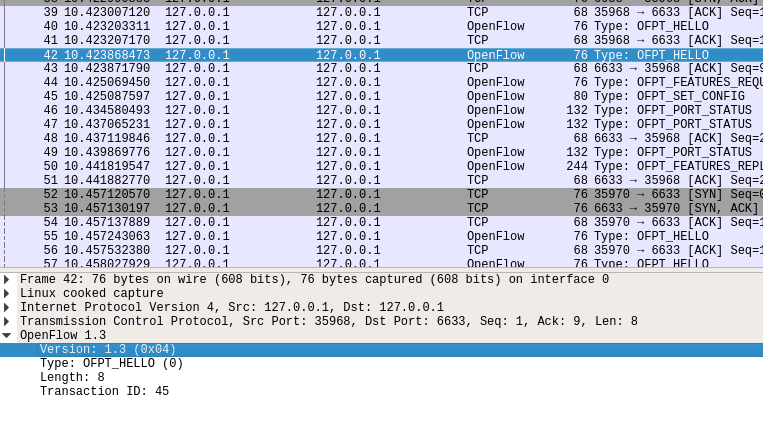
于是双方建立连接,并使用OpenFlow 1.0
Features Request
控制器6633端口(我需要你的特征信息) ---> 交换机35968端口
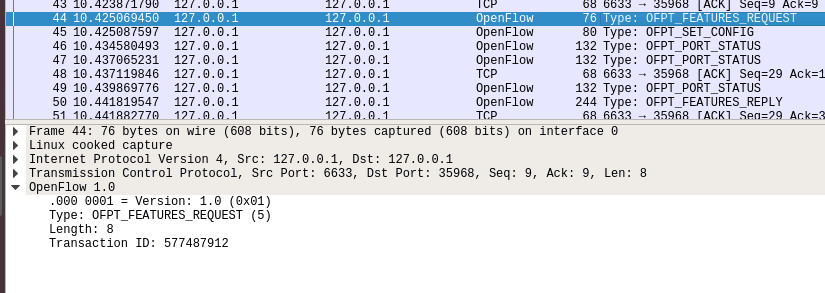
Set Config
控制器6633端口(请按照我给你的flag和max bytes of packet进行配置) ---> 交换机35968端口
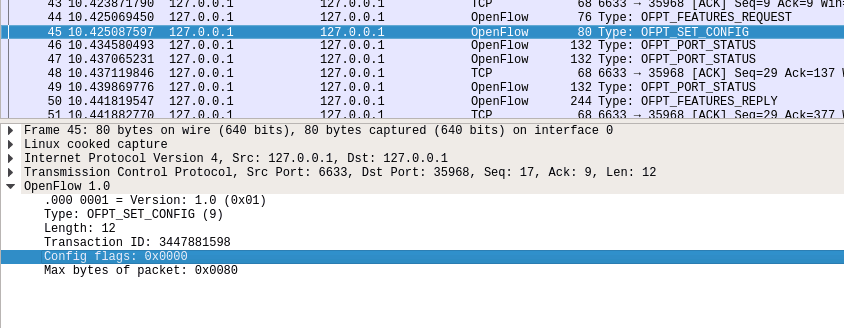
Features Reply
交换机35968端口(这是我的特征信息,请查收)--- 控制器6633端口
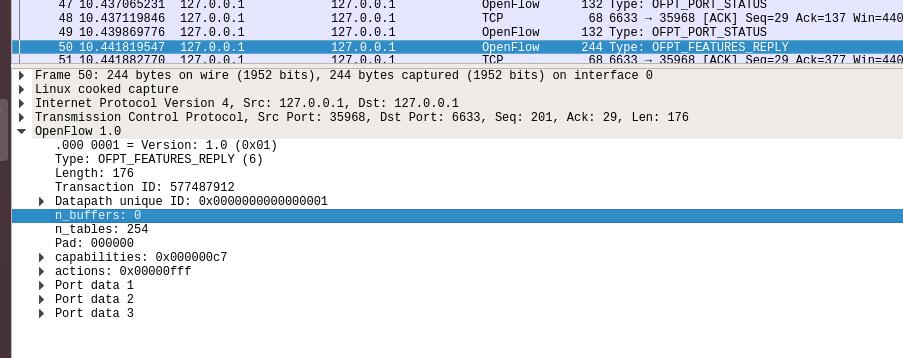
Features 消息包括 OpenFlow Header 和 Features Reply Message
对照Features Reply Message结构
struct ofp_switch_features{
struct ofp_header header;
uint64_t datapath_id; /*唯一标识 id 号*/
uint32_t n_buffers; /*交缓冲区可以缓存的最大数据包个数*/
uint8_t n_tables; /*流表数量*/
uint8_t pad[3]; /*align to 64 bits*/
uint32_t capabilities; /*支持的特殊功能,具体见 ofp_capabilities*/
uint32_t actions; /*支持的动作,具体见 ofp_actions_type*/
struct ofp_phy_port ports[0]; /*物理端口描述列表,具体见 ofp_phy_port*/
};
对应到抓取到的报文,逐项查看报文内容
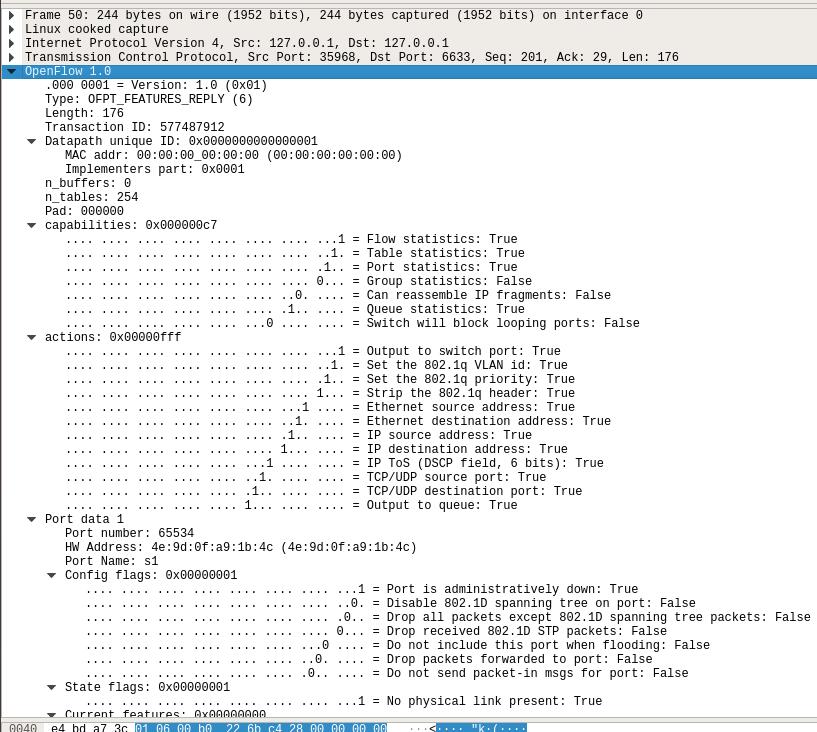
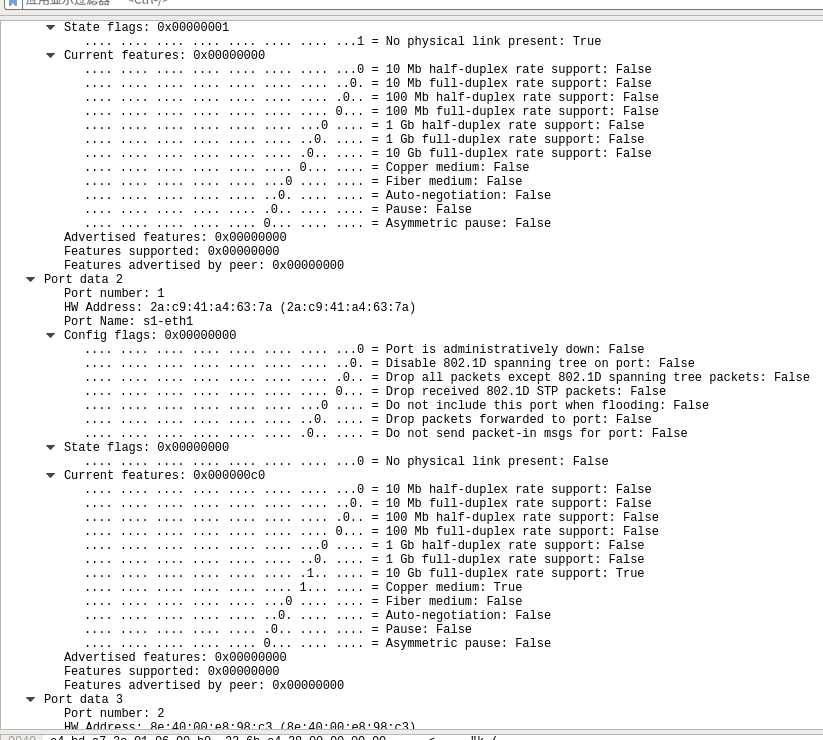
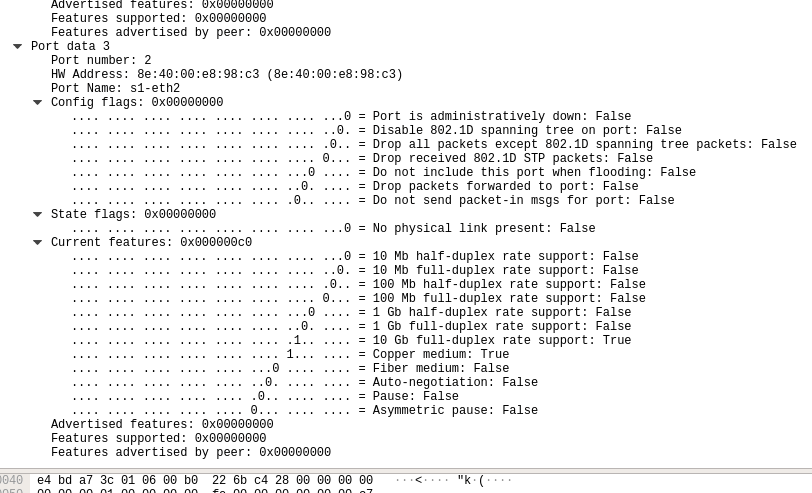
Packet_in
交换机35970端口(有数据包进来,请指示)--- 控制器6633端口
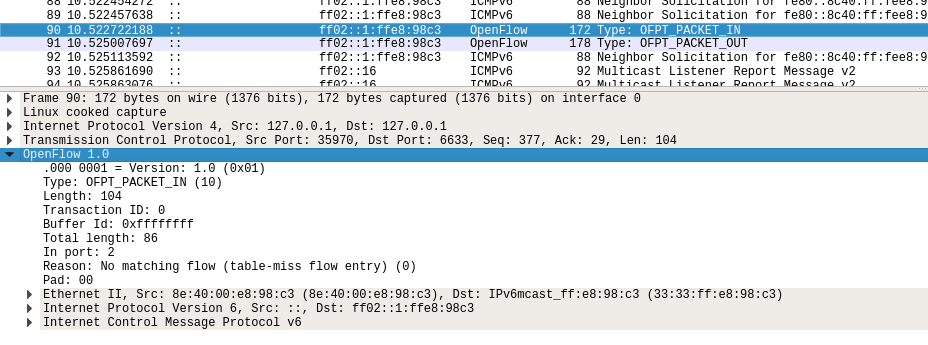
结合Packet_in的结构
struct ofp_packet_in {
struct ofp_header header;
uint32_t buffer_id; /*Packet-in消息所携带的数据包在交换机缓存区中的ID*/
uint16_t total_len; /*data字段的长度*/
uint16_t in_port; /*数据包进入交换机时的端口号*/
uint8_t reason; /*发送Packet-in消息的原因,具体见 ofp_packet_in_reason*/
uint8_t pad;
uint8_t data[0]; /*携带的数据包*/
};
分析抓取的数据包,可以发现是因为交换机发现此时自己并没有匹配的流表(Reason: No matching flow (table-miss flow entry) (0)),所以要问控制器如何处理
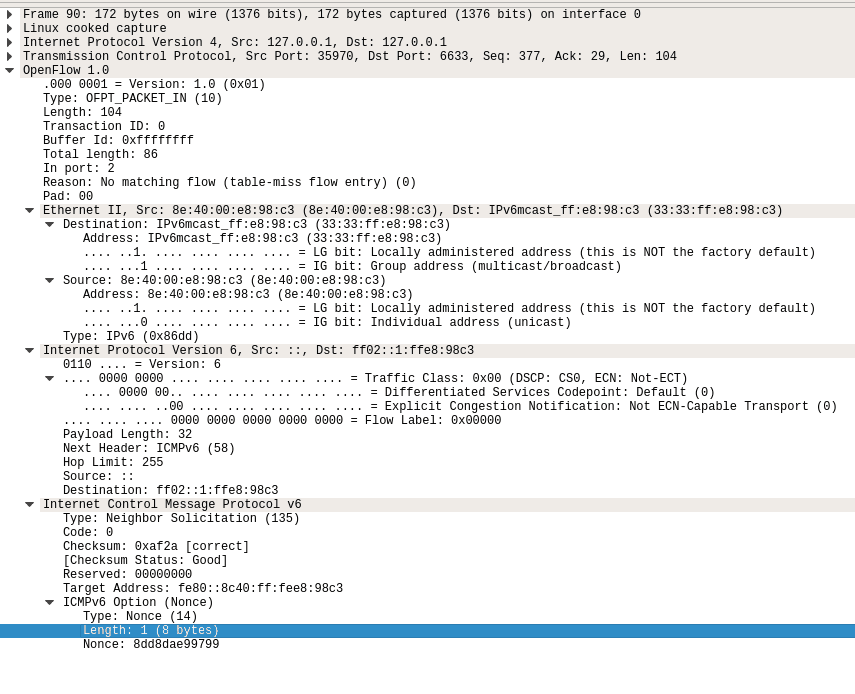
Packet_out
控制器6633端口(请按照我给你的action进行处理) ---> 交换机35970端口

结合Packet_out的结构
struct ofp_packet_out {
struct ofp_header header;
uint32_t buffer_id; /*交换机缓存区id,如果为-1则指定的为packet-out消息携带的data字段*/
uint16_t in_port; /*如果buffer_id为‐1,并且action列表中指定了Output=TABLE的动作,in_port将作为data段数据包的额外匹配信息进行流表查询*/
uint16_t actions_len; /*action列表的长度,可以用来区分actions和data段*/
struct ofp_action_header actions[0]; /*动作列表*/
uint8_t data[0]; /*数据缓存区,可以存储一个以太网帧,可选*/
}
告诉输出到交换机的35970端口上图报文。
接下来是另一台交换机(端口35536)与控制器(端口6633)的交互过程
h1 ping h2
flow_mod
结合flow_mod结构
struct ofp_flow_mod {
struct ofp_header header;
struct ofp_match match; /*流表的匹配域*/
uint64_t cookie; /*流表项标识符*/
uint16_t command; /*可以是ADD,DELETE,DELETE-STRICT,MODIFY,MODIFY-STRICT*/
uint16_t idle_timeout; /*空闲超时时间*/
uint16_t hard_timeout; /*最大生存时间*/
uint16_t priority; /*优先级,优先级高的流表项优先匹配*/
uint32_t buffer_id; /*缓存区ID ,用于指定缓存区中的一个数据包按这个消息的action列表处理*/
uint16_t out_port; /*如果这条消息是用于删除流表则需要提供额外的匹配参数*/
uint16_t flags; /*标志位,可以用来指示流表删除后是否发送flow‐removed消息,添加流表时是否检查流表重复项,添加的流表项是否为应急流表项。*/
struct ofp_action_header actions[0]; /*action列表*/
};
分析抓取的flow_mod数据包

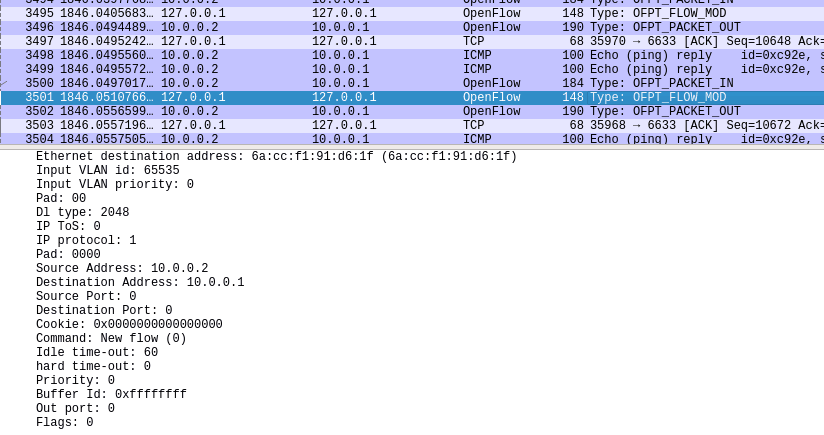
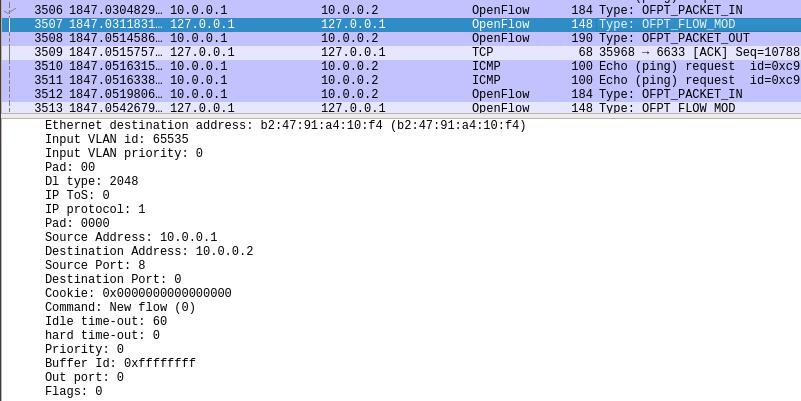
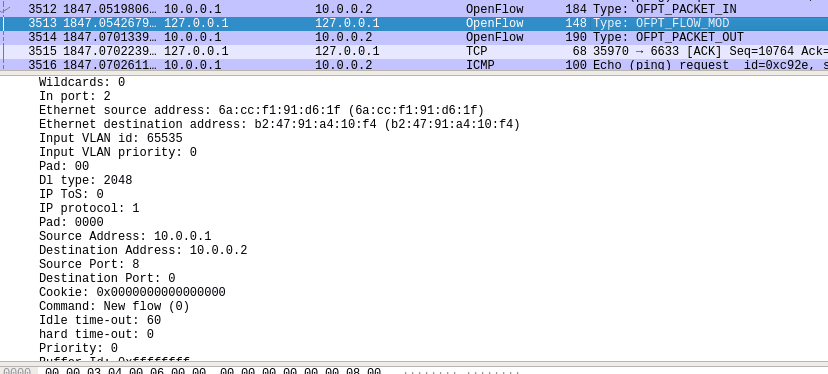
PS.把控制器从openflow reference改成ovs controller
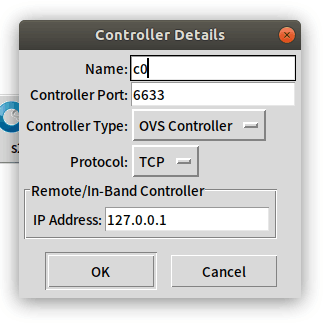
在hello报文中可以发现控制器支持的OpenFlow版本从1.0变成了1.4,因此,经过协商交换机和控制器之间将通过1.3版本的OpenFlow协议进行通信
